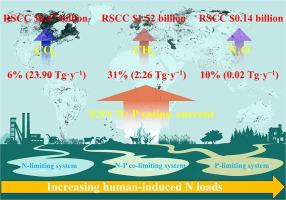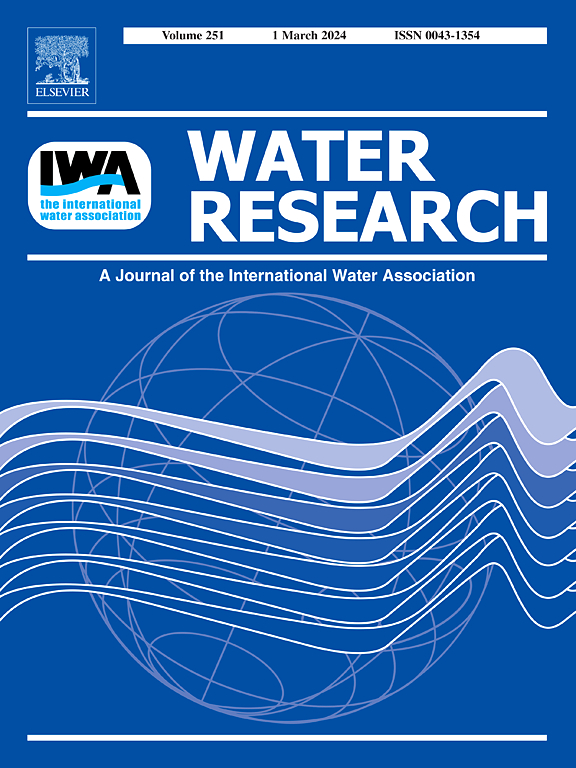Human-induced N-P imbalances will aggravate GHG emissions from lakes and reservoirs under persisting eutrophication
IF 11.4
1区 环境科学与生态学
Q1 ENGINEERING, ENVIRONMENTAL
引用次数: 0
Abstract
Lakes and reservoirs are hotspots for emissions of atmospheric greenhouse gas (GHG) such as CO2, CH4, and N2O, and their nutrient levels and stoichiometric status are significant drivers of GHG emissions. In recent decades, human-induced unbalanced inputs of nitrogen (N) and phosphorus (P) have enhanced the P-limiting state of inland lake and reservoir systems. However, it remains unclear whether this state transition involves global changes in nutrient-limiting systems and GHG emissions from lakes and reservoirs. In this study, a comprehensive model was developed to examine the relationship between GHG fluxes and total N (TN) and total P (TP) to predict future human-induced N over-enrichment and its impact on global GHG emissions. Our results show that excess N inputs amplified GHG emissions, with future water eutrophication (1.2×) projected to increase CO2 emissions (384.66 Tg·y−1), CH4 (7.38 Tg·y−1), and N2O (0.23 Tg·y−1) from lakes and reservoirs by 49 %, 12 %, and 25 %, respectively, amounting to approximately US$0.13 trillion ($0.08–6.91 trillion, 2015$) in social costs. A future 50 % increase in N: P will increase the relative social cost of carbon by 15 % compared to future 1.2× eutrophication levels. Given the social costs and benefits of reducing N and P pollutants in water individually and in synchronization, future long-term strategies for managing eutrophication in lakes and reservoirs need to emphasize balanced control of N and P.


人类引起的氮磷失衡将加剧湖泊和水库持续富营养化的温室气体排放
湖泊和水库是大气中CO2、CH4和N2O等温室气体排放的热点,其营养水平和化学计量状态是温室气体排放的重要驱动因素。近几十年来,人为氮、磷输入失衡加剧了内陆湖泊和水库系统的限磷状态。然而,尚不清楚这种状态转变是否涉及营养限制系统和湖泊和水库温室气体排放的全球变化。本研究建立了温室气体通量与总氮(TN)和总磷(TP)关系的综合模型,以预测未来人类引起的氮过度富集及其对全球温室气体排放的影响。研究结果表明,过量的氮输入放大了温室气体排放,未来水体富营养化(1.2倍)预计将使湖泊和水库的二氧化碳(384.66 Tg·y - 1)、CH4 (7.38 Tg·y - 1)和N2O (0.23 Tg·y - 1)排放量分别增加49%、12%和25%,社会成本约为0.13万亿美元(0.08-6.91万亿美元,2015年美元)。与未来1.2倍的富营养化水平相比,未来氮磷增加50%将使碳的相对社会成本增加15%。考虑到单独和同步减少水体中氮磷污染物的社会成本和效益,未来管理湖泊和水库富营养化的长期战略需要强调氮磷的平衡控制。
本文章由计算机程序翻译,如有差异,请以英文原文为准。
求助全文
约1分钟内获得全文
求助全文
来源期刊

Water Research
环境科学-工程:环境
CiteScore
20.80
自引率
9.40%
发文量
1307
审稿时长
38 days
期刊介绍:
Water Research, along with its open access companion journal Water Research X, serves as a platform for publishing original research papers covering various aspects of the science and technology related to the anthropogenic water cycle, water quality, and its management worldwide. The audience targeted by the journal comprises biologists, chemical engineers, chemists, civil engineers, environmental engineers, limnologists, and microbiologists. The scope of the journal include:
•Treatment processes for water and wastewaters (municipal, agricultural, industrial, and on-site treatment), including resource recovery and residuals management;
•Urban hydrology including sewer systems, stormwater management, and green infrastructure;
•Drinking water treatment and distribution;
•Potable and non-potable water reuse;
•Sanitation, public health, and risk assessment;
•Anaerobic digestion, solid and hazardous waste management, including source characterization and the effects and control of leachates and gaseous emissions;
•Contaminants (chemical, microbial, anthropogenic particles such as nanoparticles or microplastics) and related water quality sensing, monitoring, fate, and assessment;
•Anthropogenic impacts on inland, tidal, coastal and urban waters, focusing on surface and ground waters, and point and non-point sources of pollution;
•Environmental restoration, linked to surface water, groundwater and groundwater remediation;
•Analysis of the interfaces between sediments and water, and between water and atmosphere, focusing specifically on anthropogenic impacts;
•Mathematical modelling, systems analysis, machine learning, and beneficial use of big data related to the anthropogenic water cycle;
•Socio-economic, policy, and regulations studies.
 求助内容:
求助内容: 应助结果提醒方式:
应助结果提醒方式:


